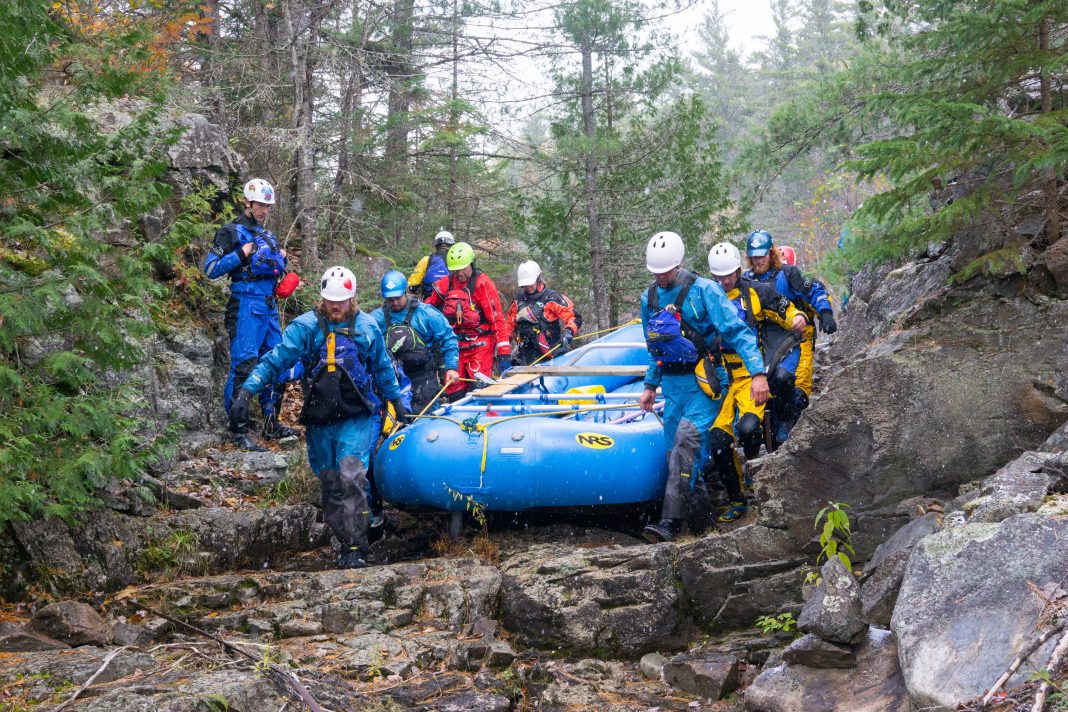I write this after just returning from probably my last river trip of the 2018 season. Five days on Algonquin Park’s classic Petawawa River, in oar rigs with my second-year, guide-training diploma students.
Late fall means daytime temperatures just above freezing, early nightfall, and rain-fed high water on this undammed river. Drysuits, cold hands and feet, a down coat in camp and early bedtimes are the rules.
Some might call it miserable, but every year I look forward to it.
How Log Drivers Contributed To River Running
The section of the river we run, Lake Traverse to McManus Lake, has a couple of significant drops, all runnable with oars, and dozens of smaller ledges and continuous rapids.
Perfect eastern multi-day rafting. There is one kicker though: Crooked Chute. As the crux rapid, Crooked Chute has an accelerator entry, a 100-degree right-hand elbow, and two holes flanked by pinning rocks. Technical class III at the lowest levels, beefy IV in mid-range to scary V at higher levels. It does not take much water to change the tone of this rapid.
Late fall rain means we saw higher water this year. A solid class V. There was a line to be found, but it was tight, fast, carried big consequences, and we were two days from the nearest road. Not a place for institutional raft trips like a college training program. We were walking.
Sounds terrible, right? Portaging four loaded oar rigs, coolers, boxes and piles of drybags with winter gear. But it is hands-down the easiest portage in all of expedition rafting. Thank you, anonymous river men from a 180 years ago.
For those unfamiliar with eastern Canadian rivers, here’s a history lesson.
These rivers were the historical thoroughfares across the land. From the earliest Indigenous travelers to European explorers, then fur traders and finally loggers, rivers were industrial highways. Goods were paddled in and fur and logs floated out.
For the Petawawa, starting in about 1840, giant white pine trees standing 200 feet tall were felled and floated the 180 kilometers downstream to the Ottawa River, eventually making their way to Montreal and loaded on ships to cross the Atlantic Ocean.
This was all accomplished by the hands of intrepid log drivers, river men who rode the logs downstream or shepherded them in wooden pointer boats.This is a romantic and brutal era in Canadian history, pre-dating life jackets and, for most of these farm boys, the ability to swim.
On their way upstream in the fall—the log drivers would spend the winter in bush camps cutting trees—the log drivers would ‘clean’ the river.
Which means, they removed the inhibiting rocks. By hand.
Stacked alongside the biggest rapids—Poplar Falls, Devil’s Cellar—are rows 300 feet long, six feet high of rocks removed from the rapids. Thousands of them and none smaller than 50 pounds. Flowing class II was once bouldery class III. What is now class IV would have been unrunnable.
Make no mistake, any raft guide goes to great lengths to avoid portaging. But if one has to do it, it does not get better than this.
This brings us back to Crooked Chute.
Too tight and treacherous to run huge logs down, the river men blasted and hacked a perfect 12-foot wide, flat-bottomed, downhill-sloped shortcut channel to skip the crux. Metal rails easily moved logs and wooden boats past the gnar. This was somewhere around 1845. When the river drive era ended in 1912, the channel, and the river itself was abandoned. It was not until whitewater paddlers showed up some 50 years later the work of these river men was put back to use, this time to portage canoes, and now my trip’s four oar rigs.
Make no mistake, any raft guide goes to great lengths to avoid portaging. But if one has to do it, it does not get better than this. Some technical lining and lowering get the boats to the channel entrance— blowing this at the lip of a class V rapid is not an option. Lifting and hauling the rafts into and along the portage is hard work but takes all of 20 minutes. The steep rock walls on either side show the hours and hours of labor to cut the channel and stack the rocks to either side.
It is an unbelievable human accomplishment, hidden deep in the wilderness, seen by very few modern travellers.
The work is anonymous, not commemorated and completely humbling. Only twice have I had to portage rafts here due to high water. Each time our group landed in camp, changed into our down and fleece, ate a gourmet commercial-camp-kitchen dinner, and marvelled at the work of those who worked this river before us. It was not lost on any of us today thanks to the anonymous river men from a 180 years ago, we have it so good.
Caught between a rock and a hard place. Feature Photos: Luke Laurin Author: Jeff Jackson




